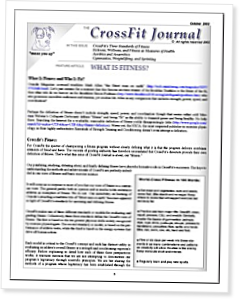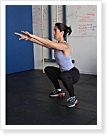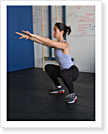In Basics, Classic, CrossFit, ExPhysiology, Reference
October 01, 2002
What Is Fitness and Who Is Fit?
Outside Magazine crowned triathlete Mark Allen "the fittest man on earth." Let’s just assume for a moment that this famous six-time winner of the IronMan Triathlon is the fittest of the fit, then what title do we bestow on the decathlete Simon Poelman who also possesses incredible endurance and stamina, yet crushes Mr. Allen in any comparison that includes strength, power, speed, and coordination?
Perhaps the definition of fitness doesn’t include strength, speed, power, and coordination though that seems rather odd. Merriam Webster’s Collegiate Dictionary defines "fitness" and being "fit" as the ability to transmit genes and being healthy. No help there. Searching the Internet for a workable, reasonable definition of fitness yields disappointingly little. Worse yet, the NSCA, the most respected publisher in exercise physiology, in their highly authoritative Essentials of Strength Training and Conditioning doesn’t even attempt a definition.
Crossfit's Fitness
For CrossFit the specter of championing a fitness program without clearly defining what it is that the program delivers combines elements of fraud and farce. The vacuum of guiding authority has therefore necessitated that CrossFit’s directors provide their own definition of fitness. That's what this issue of CrossFit Journal is about, our "fitness."





34 Comments on “What Is Fitness?”
1
wrote …
The section "The First Fitness Standard" which describes the 10 attributes of fitness actually only lists 9 of the 10 attributes. "Speed" should have been listed as well. I've read this article half a dozen times and caught the omission only just now.
Login to reply to this comment
Permalink
2
wrote …
Just a head's up: the link to Simon Poelman's bio page on that site has changed to http://www.decathlon2000.ee/eng/athletes.php?art=573
Login to reply to this comment
Permalink
3
Joey Dussel replied to comment from John Maloney…
I was going to say that also.
Login to reply to this comment
Permalink
4
wrote …
The pdf will not print. Has anyone else had this problem? I'd like to print it and show my friends. Can someone check the link to see if its got a problem? Thanks!
Login to reply to this comment
Permalink
5
wrote …
If anyone comes to Charlottesville feel free to drop by our CrossFit box. This article is a classic. We also have a good CrossFit Charlottesville FAQ
Login to reply to this comment
Permalink
6
wrote …
The third pathway, the oxidative, dominates
low-powered activities, those that last in excess of several min-
utes. Here’s an excellent reference for additional information: http:
//predator.pnb.uconn.edu/beta/virtualtemp/muscle/exercise-folder/
muscle.html
The above link doesn't work. Can anyone recommend an alternate link that goes into the 3 pathways in detail?
Thanks,
Charles
Login to reply to this comment
Permalink
7
wrote …
@Charles Bram, this link may be useful to explain:
http://www.bio.miami.edu/~cmallery/150/physiol/energy.htm
Login to reply to this comment
Permalink
8
wrote …
This document blew my mind when I first read it and still does to this day. It is revolutionary.
Login to reply to this comment
Permalink
9
wrote …
@Eugene Thank you. I just now saw the response you left me.
Login to reply to this comment
Permalink
10
wrote …
This article sums it up the best. About 99% of the questions I have been asked about CrossFit are answered in "What is Fitness?".
-Rick
Aliso CrossFit
Aliso Viejo, CA
Login to reply to this comment
Permalink
11
wrote …
I recently failed my level 1 test by one lousy mark. Some of the questions within the test were not in the training guide provided. For example the info on macro and micronutrients plus a few more. Were we meant to receive any other booklets? Or does anyone know where i can learn more about the nutrition side of it without being too broad?I now have to travel 3500km to re-sit so I really NEED to pass this time. Any help would be MASSIVELY appreciated!! :)
Login to reply to this comment
Permalink
12
wrote …
As a medical student (and hopefully future sports medicine practitioner) and an avid Crossfitter, I always found a discrepency among medical fitness prescriptions and that of CrossFit until I read this article (http://journals.lww.com/acsm-msse/Abstract/2011/07000/Quantity_and_Quality_of_Exercise_for_Developing.26.aspx) It's as if I read the "What is Fitness" article by coach in a much more lengthy, scientifically cited fashion. But the details are ALL the same! In fact, I've started giving out "what is fitness" to fellow students and practicing physicians as a layman's explanation to give to patients to help them understand what is expected of them.
Login to reply to this comment
Permalink
13
replied to comment from John Maloney…
I truly love Crossfit, but I truly have a difficult time with tests in general I usually have to take them 3-6 times before I pass. I believe I have test anxiety syndrome!!! So on the test is does ask what is the Crossfit definition of "Fitness" and there are quite a few possible answers, can someone please tell me the correct answer! Here is something my husband gave to me today when I found out that I failed once again on my test, maybe it can help you to...It is impossible to live without failing at something, unless you live so cautiously that you might as well not have lived at all- in which case, you fail by default.
-J.K. Rowling
Have a good day fellow Crossfitters!!
Login to reply to this comment
Permalink
14
wrote …
I am taking the certification on Nov 17. I have read the training guide and I am working on the article "What is Fitness now." Anything else anyone recommend I study? Thanks!
Login to reply to this comment
Permalink
15
wrote …
@Justin Reyes
The reading that you have done will only help you turn pages when they reference them at the cert, not to say that reading it's contents in full won't help you, it will, but that all of the instruction is based on that text so it will all sound familiar. Take an extra binder that you will dedicate as your CrossFit binder and take notes. The instruction, demonstration, and coaching tips you will get are phenomenal as well as the eye candy i.e. Miranda, Julie, Camille (cross your fingers that one of them attend). Again if you know the material, you'll pass, so pay special attention to how they coach a client and try to take that away from the cert. The girls, Spealler, Khalipa, Maddox, Lipson, and Chan are all amazing coaches as they are athletes. Also any article or video here on the journal are extremely helpful.
Cheers!
Login to reply to this comment
Permalink
16
replied to comment from Marie Sheehan…
regarding saving as a pdf
1. hover your mouse up the top right of your computer over the "TOOLS" icon. It looks like a round circle with blunt spikes on it (not the star or little house)
2. click on the tools icon
3. file
4. save as...
5. save as you want it
Login to reply to this comment
Permalink
17
wrote …
"Merriam Webster’s Collegiate Dictionary defines "fitness" and being "fit" as the ability to transmit genes and being healthy. No help there."
On the contrary, I think it says it all! In evolutionary terms "the strong survive" and the survivors have a better chance of propagating. Therefore crossfitters, who are more apt to survive an unknown and unfortunate incident, have a higher likelyhood of transmitting their genes than a couch potato or meathead!
Login to reply to this comment
Permalink
18
wrote …
A great opportunity for everyone to the community having access to a valuable education and resources.
Buy Youtube Subsribers
Buy Vine Trial
Login to reply to this comment
Permalink
19
wrote …
Hello everyone, I'm new to crossfit. I was reading this article, and then I got confused:
From the text on page 4 and 5:
"Note that the POSPHAGEN pathway is the dominant pathway in intervals of 10-30 seconds of work followed by rest of 30-90 seconds (load:recovery 1:3) repeated 25-30 times"
then in the table (figure 3) on the page 5 it says 25-30 repetitions in OXIDATIVE and 3-5 in POSPHAGEN...
which one is 25 - 30 reps? hope some one can help me to get this information correctly...
Login to reply to this comment
Permalink
20
replied to comment from Melisa D…
@Melisa D
The difference is between the words "work" and "reps".
Posphagen is 10-30 seconds of "work" and 3-5 "reps". Within that 10-30 seconds of "work" it would be safe to say that only 3-5 "reps" of a difficult and explosive move could be performed.
Oxidative is 120-300 seconds of "work" and 25-30 "reps". It is reasonable to say that within 120-300 seconds of "work" you could complete 25-30 "reps" of a movement.
Hope that helps.
Also it was saying that the cycle of the "work", "reps", and "rest" within posphagen could be repeated 25-30 times.
Login to reply to this comment
Permalink
21
wrote …
I'm still having a difficult time understanding the text on interval training and the table (figure 3) that corresponds to the text on pages 4 & 5.
Could somebody elaborate?
Login to reply to this comment
Permalink
22
wrote …
I want to say it was a typo...
There is also an article that focuses strictly on metabolic conditioning that has the exact same table but the posphagen column indicates "25-30" reps while the oxidative column indicates "3-5" reps.
Login to reply to this comment
Permalink
23
wrote …
I do believe that Crossfit is the best conditioning sport in the world. I have been training it for a while and I ever so often teach a new move here in Brazil to one of the students at the Gym.
http://coachdavid.com.br/condicionamento-fisico/
Login to reply to this comment
Permalink
24
wrote …
Ladies and Gentlemen,
CrossFit does work wonders for many. It's revolutionary style can result in outstanding strength, power, and endurance. But CrossFit is good for becoming good at CrossFit. In the article of "defining fitness", Greg says that a Outdoor's triathlete is not the world's fittest man, but he is the world's fittest man in the sport of triathlons. And Lebron James is the world's best basketball player, and Lionel Messi is the world's best soccer player. That leaves Rich Froning, as the world's best CrossFit athlete. Fitness, when speaking about sport, is definitive in it's respective sport. In order to cross reference sport to sport, there needs to be normative references. Check back in 6 months and I'll have an answer to potentially who is, and in what sport, is the most fit. It very well could be CrossFit athletes, or NFL football players, or cross country skiers. The study begins January 2015.
Cheers!
Login to reply to this comment
Permalink
25
Chris Sinagoga wrote …
"But CrossFit is good for becoming good at CrossFit"
True. And CrossFit is also good for becoming good at sports. It happens all of the time. Doesn't mean that they don't have to practice their sports, but CrossFit will give them great tools to become better at whatever it is they are doing.
The CrossFit Games are just one expression of CrossFit
Login to reply to this comment
Permalink
26
Testo Zilla wrote …
There are a lot of well fit models, its much easier to be a fitness model than to get into fashion industry. With correct advertising any fit person can become a well followed and sponsored. For example read about Nick Auger and his success.
http://testozilla.com/workout/an-insanely-perfect-fitness-model-nick-auger-and-his-workout-secrets
Login to reply to this comment
Permalink
27
Testo Zilla replied to comment from Testo Zilla…
You may also compare it with an old-school fitness model Serge Nubret, a Man, who made his path without any internet advertising.
http://testozilla.com/workout/serge-nubret-a-never-forgotten-icon
Login to reply to this comment
Permalink
28
wrote …
This is very helpful to me.
Login to reply to this comment
Permalink
29
wrote …
Hi. I'm re taking my L1 very soon. Needing to get better in the movement section with the test. Any helpful sites? Thanks! :)
Login to reply to this comment
Permalink
30
replied to comment from Candace Dudgeon…
"By way of a comparison. I want to look at typing, shooting, playing the violin, NASCAR driving and CrossFit. What these domains have in common is that a marked proficiency is associated with speed. Being able to shoot accurately and quickly is better than quickly or accurately. You may try to get a job as a typist because you do not make any mistakes. However, for this perfection, you type at a rate of 20 words a minute and only use two fingers. You will never get hired. Playing the violin fast and error-free is critical for a virtuoso. However, someone who gets through “Flight of the Bumble Bee” in 12 minutes is not there yet. A NASCAR driver wants to both drive fast and not wreck. In CrossFit, a perfectly exquisite Fran is worthless if it takes 32 minutes. And yet, it is presented to CrossFit coaches as, “Should I use good form or should I do it quickly?” I do not like my choices. One is impossible without the other. Technique and speed are not at odds with one another, where “speed” is related to all the quantification of the movement: power, force, distance, time. They are seemingly at odds. It is a misapprehension. It is an illusion. Can you learn to drive fast without wrecking? Can you learn to type fast without making errors? Can you shoot quickly without missing? Eventually, but not in the learning. One is impossible without the other. You will not learn to type fast without typing where you make a ton of errors and then work to reduce the errors at that speed. Then you go faster, and then again pull the errors back in, then go faster and pull the errors back in. You drive faster and faster and then you spin out in the infield or you hit the wall. If you are a race driver and you have never spun out, gone out in the infield or never been in a wreck, you are not very good. If you are a typist and you have never made a mistake, you are very slow. In CrossFit, if your technique is perfect, your intensity is always low. Here is the part that is hard to understand: You will not maximize the intensity or the speed without mistakes. But it is not the mistakes that make you faster. It is not reaching for the letter P with your pinky and hitting the O. It is not hitting the wrong note that made you play faster. It is not missing the target by two feet that made you a better shooter. It is not running into the wall that made you a faster driver. But you will not get there without it. The errors are an unavoidable consequence of development. This iterative process of letting this scope of errors broaden then reducing them without reducing the speed is called “threshold training.” In a CrossFit workout, if you are moving well, I will tell you to pick up the speed. Suppose at the higher speed, the movement still looks good: I will encourage you to go faster. And if it still looks good, I will encourage you to go even faster. Now the movement starts falling apart. I do not want you to slow down yet. First, at that speed I want you to fix your technique. What you need to do is continuously and constantly advance the margins at which form falters. We are the technique people. We drill technique incessantly, but simultaneously I want you to go faster. You will learn to work at higher intensity with good technique only by ratcheting up the intensity where good technique is impossible. This dichotomy means that it is impossible at the limits of your capacity to obey every little detail and nuance of technique. Some of the refined motor-recruitment patterns are not going to always look perfect. I do not know of a domain where speed matters and technique is not at the heart of it. In every athletic endeavor where we can quantify the output, there is incredible technique at the highest levels of performance." - Greg Glassman
Watch "Movements" on YouTube
Movements: http://www.youtube.com/playlist?list=PL2YcELDx9HPd7Kf_E00E4C-etfFUVnjn0
Watch "Workouts" on YouTube
Workouts: http://www.youtube.com/playlist?list=PL2YcELDx9HPd0hmN4_7JvLm18noBAE-8l
Hope this helps. ;)
Login to reply to this comment
Permalink
31
wrote …
great journal - am keen to see what other notes I can make throughout this whole journal. It is so nice to see a whole community of people who have the same drive and passion, helping each other on.
Login to reply to this comment
Permalink
32
wrote …
Great article .attachment document is very nice and not easy to found
security camera installation
Login to reply to this comment
Permalink
33
replied to comment from momo chen…
intercom installation
Login to reply to this comment
Permalink
34
wrote …
Fitness, to me, means more than just exercise, or good diet, etc. Fitness means an overall healthy lifestyle, and making decisions based on positive motivation rather than shame or punishment. That's why there's a difference between a "fitness coach", and a "personal trainer" or "nutritionist". You know what I mean? Fitness addresses everything, and requires a sympathetic approach so as to keep people wanting to continue and grow that healthy lifestyle. I really like the approach that Jereme at Root Fitness & Nutrition (RootFitnessAndNutrition.com) brings to the game, as it truly explains what "fitness" is and how it can be achieved and maintained.
Login to reply to this comment
Permalink
Leave a comment